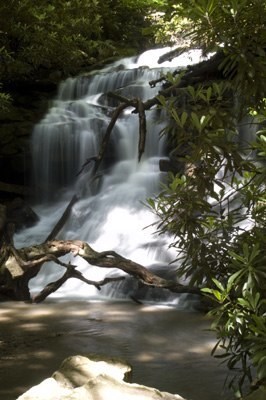
NPS | Steve Dean 
The Trail network provides access to many unique ecosystems within five distinct geographic regions. The following is adapted from a 1997 "white paper" by Philip W. Ogilvie, Ph.D., articulating the significance of the corridor in our Nation's evolution and the associated ecological and economic changes. Ecology, Economy and ChangeThe Potomac Basin has been shaped and reshaped throughout time as each resident human society over the last 14,000 years has left its mark. A slow deterioration, due mostly to anthropogenic forces, has recently turned into a rapid destruction of habitat coupled with industrialization and overpopulation. The tides are slowly turning in the other direction, with the past 50 years witnessing a slow repair of natural ecosystems. For example, the recent efforts to bring back American shad, a species once economically important, have been successful, but only to a point. The numbers of shad are growing but it is still unlawful to catch and keep shad.
The Formation of the BasinIn 1886, William Morris Davis of the Pennsylvania Geological Survey published a paper called "Rivers and Valleys of Pennsylvania"; with a few corrections, this paper is still applicable today and describes four major physical factors that shape rivers: 1) the formation of wind and water gaps by erosion; 2) headwater migration of divides; 3) stream piracy; and 4) adjustments to stream structure. Scientists think that many millions of years ago a super continent, called Pangea, began to break apart to form the modern continents. The topographic changes occurring after the continental split have resulted in the present Chesapeake Bay and Potomac River basin:
Everyday Ecology in the Potomac BasinThe Potomac River corridor can be divided into six physiographic sections: the sediment-covered Coastal Plain, divided from the Piedmont by the fall line; the ancient crystalline rock of the Blue Ridge; the Great Valley, from the Shenandoah Valley south of the River to the Cumberland Valley north of the River; the rippled Ridge and Valley portion of the Appalachian Highlands; and the eastern front of the Allegheny Plateau. Traveling through these regions is a vast window into geology and geomorphology--the study of the earth's physical makeup and the earth's physical changes, respectively. And this opportunity is a primary reason that Congress authorized the Potomac Heritage National Scenic Trail. Traveling Back in Time on the Potomac RiverThrough studying the rocks of the basin and having the opportunity to visit these special ecosystems, we travel back in time. Fossils and pollen allow us to reconstruct the changes in environment over time until the archaeological record begins in the late Pleistocene era. We still have remnants of ice age ecosystems in the basin today. These are best described as "muskegs," an Algonquian word meaning "trembling earth." Locally they are called quaking bogs, glades, swamps, marshes and bogs. Muskegs are at high enough altitudes (ca. 1,000 meters) for frost to occur in summer, acting as a natural "refrigerator." Cranesville Swamp in Garrett County, Maryland, is a good example. Many arctic plants and animals have their southernmost distribution in these muskegs
Researching Nature at Potomac Heritage TrailThe Potomac Heritage Trail is a natural oasis for visitors and for scientific researchers because of its protected natural landscape. The research done here provides the accurate and current natural resource information we need to provide to best care for the park. Scientists look at what key resources are present in the park, if they are stable or changing, how ecosystems are changing over time, and how much change is normal. Like a physician monitoring a patient's heartbeat and blood pressure, National Park Service ecologists with the National Capital Region Inventory & Monitoring Network collect long-term data on forest vegetation, bird and amphibian communities, water quality, and other key resources in national parks that make up the Potomac Heritage Trail, analyze the monitoring results, and share them. |
Last updated: August 14, 2025
